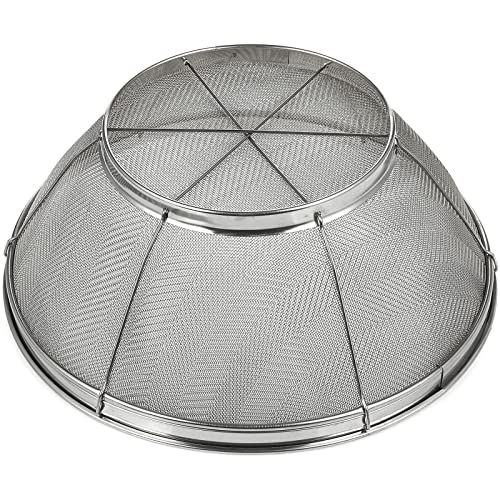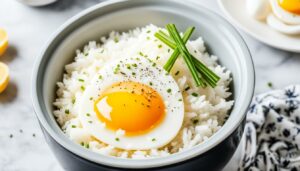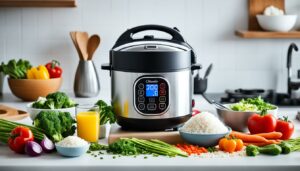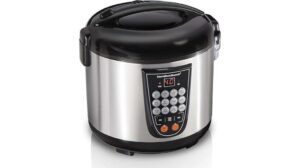In a world where we are bombarded with options for instant gratification, the art of cooking has become a lost skill. However, for those who still value the satisfaction that comes from creating something from scratch, there is no greater joy than mastering the art of cooking pho rice noodles. But be warned, this is not an easy task – it requires precision and attention to detail.
The journey to perfecting your pho rice noodles starts with selecting the right type of noodle. The wrong type can ruin your dish entirely – so choose wisely! Once you have selected your noodle, it’s time to delve into the intricacies of preparing them just right. This involves delicate steps such as soaking, straining, and rinsing – all important elements that cannot be overlooked if you desire perfection in your dish. So buckle up and join me on this culinary adventure as we explore how to cook pho rice noodles like a pro.
Table of Contents
Choose the Right Type of Rice Noodles
The selection of rice noodles for pho preparation is a crucial decision, as the different types can significantly affect the texture and overall flavor profile of the dish. Rice noodle varieties come in various thicknesses, shapes, and compositions, each with unique characteristics that impact how they cook and taste. It is essential to choose the type that best suits your preferences to achieve the ideal pho experience.
Texture preferences play a significant role when selecting rice noodles for pho. Some people prefer their noodles soft and chewy while others like them firm and springy. The thickness of the noodle also affects its texture; thinner noodles tend to be softer than thicker ones. Additionally, some varieties have added ingredients such as tapioca or cornstarch that give them a slightly different texture.
- No hydrogenated fats or high fructose corn syrup allowed in any food
- No bleached or bromated flour
- No synthetic nitrates or nitri
Prices pulled from the Amazon Product Advertising API on:
Product prices and availability are accurate as of the date/time indicated and are subject to change. Any price and availability information displayed on [relevant Amazon Site(s), as applicable] at the time of purchase will apply to the purchase of this product.
To achieve an authentic pho experience, it is important to select high-quality rice noodles that are specifically made for this dish. Cheaper alternatives may not hold up well during cooking or absorb the flavors of the broth as well as their premium counterparts. Therefore, taking time to research and source good quality rice noodles should be an integral part of your pho-making process if you want to impress yourself or your guests with delicious homemade pho.
Preparing the Noodles
As if cooking rice noodles isn’t already difficult enough, preparing them requires even more attention to detail. Soaking the noodles is a process that can go wrong in so many ways – too long and they become mushy, too short and they remain hard. And don’t even get me started on cooking the noodles – one minute too long or too short and you might as well just throw them out. But hey, no pressure, right?
Soaking the Noodles
To prepare the pho rice noodles, immerse them in a bowl of room-temperature water and let them soak for at least 30 minutes until they become soft and pliable. But wait! Don’t just throw them in the water haphazardly like some kind of amateur cook. Follow these soaking techniques to ensure that your noodles achieve the perfect texture:
- Use enough water to fully submerge the noodles without overcrowding.
- Stir occasionally during soaking to prevent clumping.
- Taste test periodically to ensure the desired softness is achieved.
Now, if you’re one of those lazy cooks who think any old noodle texture will do, then feel free to skip these steps and risk ending up with undercooked or overcooked noodles. But if you’re a true perfectionist who understands that every aspect of dish matters, then take the time to properly soak your pho rice noodles for a truly satisfying culinary experience.
Cooking the Noodles
One essential step in preparing a bowl of delicious Vietnamese soup is to ensure the noodles are cooked to perfection, with just the right amount of chewiness. Because let’s be real, what could ruin a steaming hot bowl of pho more than overcooked or undercooked rice noodles? It’s like expecting a great first date and ending up with someone who talks about their ex all night long. No thanks.
To achieve that perfect noodle texture, it’s important to pay attention to cooking time. Overcooking can result in mushy noodles that simply disintegrate in your mouth, while undercooking can leave you feeling like you’re chewing on rubber bands. It’s all about finding that sweet spot where the noodles have enough bite without being too tough. Here’s a handy table to help guide you through the process:
| Noodle Type | Soaking Time | Cooking Time |
|---|---|---|
| Thin | 30 minutes | 1-2 minutes |
| Medium | 45 minutes | 2-3 minutes |
| Thick | 1 hour | 3-4 minutes |
So go ahead and take your time when cooking those pho rice noodles – trust us, it’ll be worth it in the end. And remember, if anyone tells you that their way of cooking them is better than yours, just smile politely and continue slurping away at your perfectly cooked bowl of pho.
Straining and Rinsing the Noodles
After boiling the pho rice noodles for a few minutes, they should be immediately transferred to a colander and rinsed thoroughly with cold water to remove excess starch and prevent clumping. It is essential to take note of the water temperature while cooking the noodles as it directly affects their texture. A quick tip would be to boil the noodles in hot water for around three minutes, then transfer them to cold water for another minute or so.
When straining and rinsing the noodles, make sure that every strand gets a good wash. Clumps of un-rinsed starch can ruin your dish’s presentation and texture. And we all know how much people love complaining about soggy pho noodles! So give those noodles a good shake in the colander, rinse them under cold running water until you see no more cloudiness coming out from them.
Storage tips are important when it comes to keeping leftover pho rice noodles fresh. Some noodle brands can last longer than others, but generally speaking, cooked rice noodles should be stored separately from broth or sauce in an airtight container in the refrigerator for up to two days. Before using them again, rinse them under warm water briefly before reheating or adding them back into your soup bowl. Trust me; nobody wants stale-tasting pho!
Adding the Noodles to the Broth
Once the noodles have been properly strained and rinsed, they can be added to the hot broth to complete the pho dish. However, before adding them, it is important to consider both the broth consistency and noodle texture. One slight misstep in this crucial step could completely ruin your pho experience.
Firstly, let’s talk about broth consistency. The perfect pho should have a clear and flavorful broth that isn’t too thick or too thin. If the broth is too thick, it can overpower the delicate flavor of the rice noodles, while if it’s too thin, it won’t provide enough depth of flavor for a satisfying meal. It may take some practice to get your desired consistency just right but don’t give up! A little bit of patience and experimentation will pay off in creating a bowl of pho that tastes like heaven.
Secondly, noodle texture is equally as important as broth consistency when making pho. Overcooked or undercooked noodles can make or break your dish. If you cook them for too long they’ll become mushy and lose their chewy texture which is essential in achieving an authentic pho experience. On the other hand, if they’re undercooked they’ll be tough and chewy which nobody wants to deal with! To avoid these potential disasters, follow instructions carefully on cooking times (usually around 4-6 minutes) and check regularly until you’ve found your perfect balance.
Adding noodles to your pho may seem like a simple task but there are key factors that need consideration beforehand – namely broth consistency and noodle texture. Take note of these elements before diving into preparing this popular Vietnamese dish at home because getting them wrong can lead to disappointment rather than satisfaction from our taste buds! So go forth with confidence knowing that these tips will help guide you towards creating an amazing bowl of pho every time without fail!
Serving Suggestions
After adding the carefully cooked pho rice noodles to the broth, it’s time to think about how to present this dish in a way that is visually appealing and enhances its flavor. Of course, you could just throw it all into a bowl and call it a day, but where’s the fun in that? Let’s explore some presentation tips and flavor pairings for your perfect bowl of pho.
Firstly, consider using a deep bowl instead of a shallow one. This will not only make your portion look more generous but also allow for easier noodle slurping without making a mess. Presentation-wise, you can start by placing the sliced beef on top of the noodles with bean sprouts and herbs on either side. Don’t forget to add some lime wedges for an extra pop of color!
When it comes to flavor pairing, there are endless possibilities. Here are five ideas to get you started:
- Add hoisin sauce for sweetness and sriracha for heat
- Top with thinly sliced jalapenos or chilies for spiciness
- Serve with basil leaves and mint leaves for freshness
- Add Thai basil or cilantro for even more herbal complexity
- Experiment with different condiments like fish sauce or oyster sauce
Overall, remember that presentation matters as much as taste when it comes to enjoying food. By taking these simple steps towards serving suggestions and flavor pairing, you’ll be able to impress your guests (or yourself) with a perfectly executed bowl of pho every time.
Tips and Tricks for Perfect Pho Rice Noodles Every Time
Achieving the perfect texture and consistency of the rice noodles in a bowl of pho requires meticulous attention to detail. Texture preferences vary from person to person, but generally, a chewy yet tender noodle is desired. This can be achieved by soaking the noodles for just the right amount of time before boiling them. The thickness and type of noodle also play a crucial role in achieving the desired texture.
When it comes to storing pho rice noodles, it’s important to keep them dry and away from moisture. Moisture causes clumping, which can result in uneven cooking. It’s best to store them in an airtight container or bag at room temperature until ready to use.
Flavor variations can also be achieved by selecting different types of pho rice noodles. Some varieties are thinner or thicker than others, resulting in subtle differences in texture when cooked. Additionally, some brands may add ingredients such as tapioca starch or cornstarch for added elasticity and chewiness.
Perfecting the art of cooking pho rice noodles requires attention to detail when it comes to soaking times, boiling times, noodle thickness, storage and brand selection. While some may argue that nothing beats homemade noodles, there are plenty of high-quality options available on the market that allow for delicious variations in flavor and texture. So go ahead and experiment with different types – who knows what new favorite dish you might discover!
| Column 1 | Column 2 | Column 3 |
|---|---|---|
| Texture preferences: | Chewy yet tender is generally preferred | Thicker noodles often provide more bite |
| Noodle storage: | Keep dry & away from moisture- this will avoid clumping & uneven cooking | Store at room temp in an air-tight container |
| Flavor Variations: | Different types may have subtle differences depending on thickness & any additional ingredients used (e.g., tapioca starch) | Different brands may have different variations |
Conclusion
When it comes to cooking pho rice noodles, there are a few key steps you need to follow in order to achieve the perfect texture and flavor. Firstly, it’s important to choose the right type of rice noodles – look for ones that are thin and flat, as these will cook quickly and absorb the broth well.
Next, prepare the noodles by soaking them in cold water for at least 30 minutes – this will help soften them up before cooking. Once they’re ready, strain and rinse the noodles thoroughly to remove any excess starch or debris.
When it’s time to add the noodles to your pho broth, be sure not to overcook them – they should be tender but still slightly chewy. Finally, serve your pho with fresh herbs, lime wedges and other accompaniments as desired.
In conclusion, as they say: practice makes perfect! While cooking pho rice noodles may seem daunting at first, with a little patience and attention to detail you can achieve restaurant-quality results every time. Just remember to choose the right type of noodle, soak them properly beforehand and don’t overcook them in the broth. Happy cooking!









